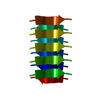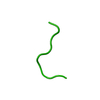+Search query
-Structure paper
| Title | Atomic structures of low-complexity protein segments reveal kinked β sheets that assemble networks. |
|---|---|
| Journal, issue, pages | Science, Vol. 359, Issue 6376, Page 698-701, Year 2018 |
| Publish date | Feb 9, 2018 |
 Authors Authors | Michael P Hughes / Michael R Sawaya / David R Boyer / Lukasz Goldschmidt / Jose A Rodriguez / Duilio Cascio / Lisa Chong / Tamir Gonen / David S Eisenberg /  |
| PubMed Abstract | Subcellular membraneless assemblies are a reinvigorated area of study in biology, with spirited scientific discussions on the forces between the low-complexity protein domains within these assemblies. ...Subcellular membraneless assemblies are a reinvigorated area of study in biology, with spirited scientific discussions on the forces between the low-complexity protein domains within these assemblies. To illuminate these forces, we determined the atomic structures of five segments from protein low-complexity domains associated with membraneless assemblies. Their common structural feature is the stacking of segments into kinked β sheets that pair into protofilaments. Unlike steric zippers of amyloid fibrils, the kinked sheets interact weakly through polar atoms and aromatic side chains. By computationally threading the human proteome on our kinked structures, we identified hundreds of low-complexity segments potentially capable of forming such interactions. These segments are found in proteins as diverse as RNA binders, nuclear pore proteins, and keratins, which are known to form networks and localize to membraneless assemblies. |
 External links External links |  Science / Science /  PubMed:29439243 / PubMed:29439243 /  PubMed Central PubMed Central |
| Methods | X-ray diffraction / EM (electron crystallography) |
| Resolution | 0.9 - 1.1 Å |
| Structure data |  PDB-6bwz:  PDB-6bxv:  PDB-6bxx:  PDB-6bzm:  PDB-6bzp: |
| Chemicals |  ChemComp-HOH:  ChemComp-TOE: |
| Source |
|
 Keywords Keywords | PROTEIN FIBRIL / Amyloid / LARKS / Reversible-amyloid / low-complexity / FG repeat |
 Movie
Movie Controller
Controller Structure viewers
Structure viewers About Yorodumi Papers
About Yorodumi Papers



 homo sapiens (human)
homo sapiens (human)